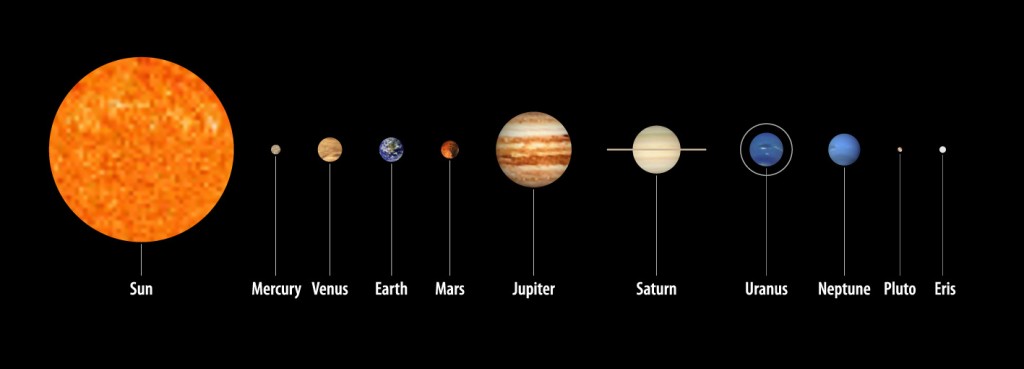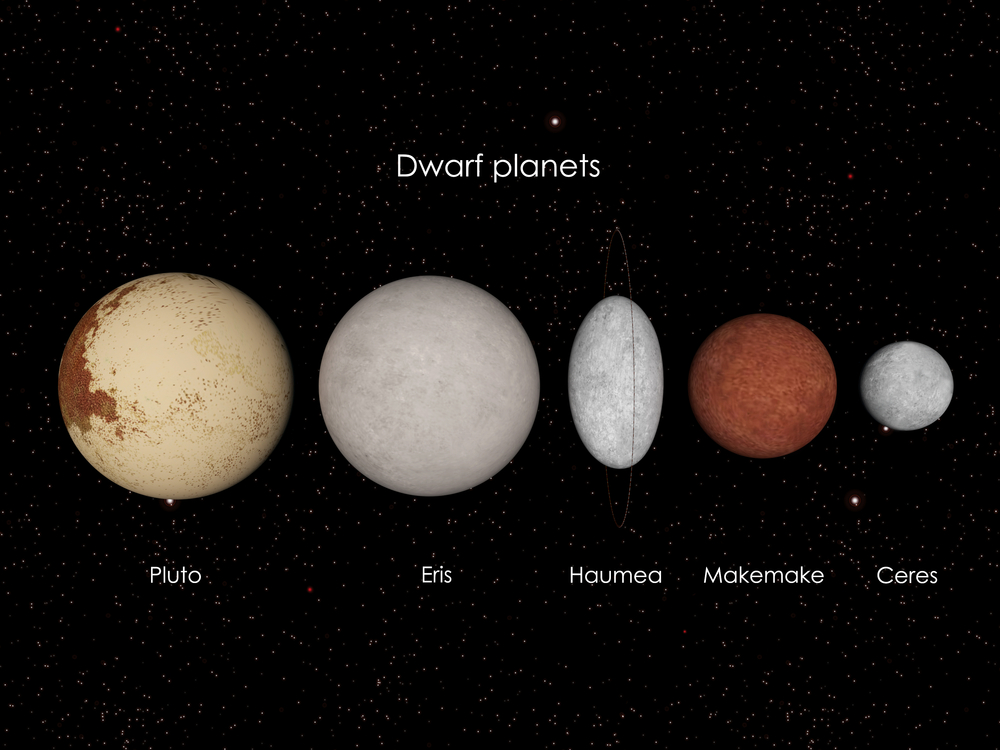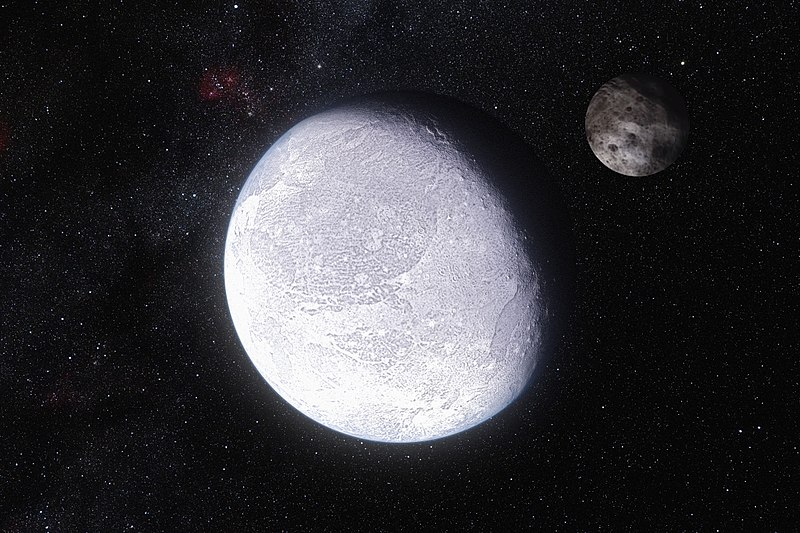Table of Contents (click to expand)
Eris is a dwarf planet situated beyond Neptune on the edge of the Kuiper Belt. It is an icy rocky planet, bigger than Pluto and twice as far from the Sun.
The Solar System is inconceivably huge. Filled with mostly empty space, we encounter planets, stars, comets and other celestial objects between massive swaths of nothingness.
Naturally, such huge scales require better means of measuring, as feet and meters become too small a unit to grasp the lengths at which the Sun exerts its enormous gravity. To do this, the distance between the Sun and Earth (93 million miles) is taken as 1 unit of astronomical measurement, called the astronomical unit (1 AU).
The strength of the Sun’s gravity can be gauged from the enormous objects that orbit it, despite being incredibly far away. One of the largest and furthest celestial bodies orbiting the Sun is the dwarf planet called Eris, which is located around 96.3 AU (8.95×109 mi, 1.441×1010 km) from the Sun—further and bigger than Pluto.

For a while, Eris became the tenth planet in our solar system after its discovery, but this was coupled with the evidence of other similar-sized objects in the solar system. These discoveries made the IAU (International Astronomical Union) change its guidelines for what constitutes a ‘planet’. Let’s have a look at the peculiarities of Eris and the change it brought about in the way we classify the solar system.
Discovery And Classification
The search team that discovered Eris was responsible for finding many other previously undiscovered large-scale celestial objects (e.g., 90842 Orcus, 50000 Quaoar, 90377 Sedna) while methodically scanning the outskirts of the solar system for years.
The images taken by the Samuel Oschin Schmidt telescope at the Palomar Observatory in California on October 21, 2003 became the solid evidence of Eris. The discovery was later announced on July 29, 2005 by the team of Chad Trujillo, Mike Brown and David Rabinowitz.

Eris gets its name from the Greek goddess – Eris, strife and discord personified. The name was a proposal by the team at Caltech, made on September 6, 2006 and subsequently assigned later on September 13, 2006.
Eris is located in the trans-Neptune orbit far beyond Pluto, at the edge of the Kuiper Belt. For comparison, Pluto is located around 40 AU from the Sun, but Eris orbits the Sun from 96.3 AU—more than double the remoteness of Pluto!
Initial observations showed that the mass of Eris was (1.66±0.02) × 1022 kg, which is about 27% greater than that of Pluto. This prompted NASA to declare Eris as the tenth planet of the solar system. This and various other reasons made the IAU change its guidelines for what it means to be a planet.
Also Read: What Are Dwarf Planets?
Eris And The Reclassification Of Planets
At the time of Eris’ discovery, the debate over Pluto’s planet status was already ongoing and the existence of a celestial body bigger than Pluto orbiting the Sun added even more fire to the debate.
This, along with the discovery of other similar-sized celestial bodies like Haumea and Makemake, prompted NASA and the IAU to reconsider what should formally define a planet.
In 2006, at a time when Eris was being considered the tenth planet, a report was published by the IAU that laid out the key criteria that enable a celestial body to be categorized as a planet:
- The celestial object should be in direct orbit of the Sun, not a satellite to another celestial body.
- The celestial object should have enough mass to achieve hydrostatic equilibrium and thus become a roundish body.
- The celestial object should have cleared the neighborhood of its orbit, meaning that it should be the dominant celestial body in its orbit.
These guidelines ousted Pluto as the ninth planet because it was not the dominant object in its orbit; the same was true in the case of Eris, so it was similarly dethroned from the category of ‘planet’. Both of these celestial bodies then became ‘dwarf planets’, along with Ceres, Makemake, and Haumea.

What Is Eris Made Of?
Eris is an icy planet with a rocky surface. Due to its enormous distance from the Sun, the surface temperatures get very low and vary from –217 degrees Celsius (-359 degrees Fahrenheit) to -243 degrees Celsius (-405 degrees Fahrenheit). Unlike Pluto’s reddish surface, Eris appears to be completely white, owing to the large distance it is from any sunlight.
In size, Eris is smaller than the Moon and is about 1/5th of Earth’s radius, which is 1163 kilometers (722 miles). The closest it gets to the Sun in its orbit is 37 AU, and the farthest it gets is about 97 AU, so light travels an average of about 9 hours from the Sun before reaching its rocky plains.

Eris completes one orbit around the Sun every 557 Earth years and completes one rotation around itself every 25.9 hours, which makes days on Eris only slightly longer than those of Earth. It has one satellite, named Dysnomia, after the demon goddess of lawlessness and daughter of the mythological Eris. This moon completes one orbit around its parent every 16 days. It is through Dysnomia that astronomers could calculate the precise mass of Eris, which helped in understanding the comparison between Pluto and Eris.
Eris is a member of the collective of celestial objects in the Kuiper Belt, which spans beyond Neptune in a disk-like formation of myriad icy worlds. Dating back about 4.5 billion years, these objects formed in the initial days of the Solar System.
There have been no direct flyby missions to Eris, but a few missions to the Kuiper Belt and the Pluto flyby have shed insight on the workings of the icy dwarf. Even so, there are still many things we don’t know about Eris, one of which is the internal structure of the dwarf planet.
Also Read: How Far Is Pluto From Earth?
Life On Eris, Or The Lack Thereof
Due to its large distance from the Sun, the atmosphere of Eris is unable to sustain, as it collapses and freezes on the surface in the form of snow. The extremely cold weather makes it highly unlikely that any form of life could survive on the dwarf planet.
How well do you understand the article above!

